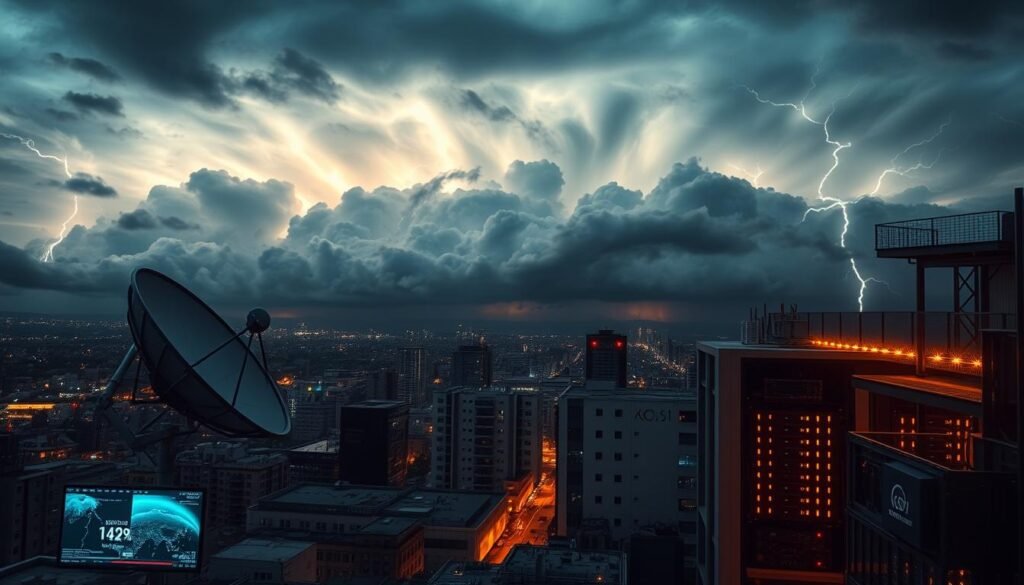What if the next cyber threat isn’t a hacker but a hurricane? While malware and phishing dominate headlines, extreme weather quietly disrupts servers, grids, and networks. Take Hurricane Sandy: it flooded data centers, shutting down hospitals and financial systems. This wasn’t just a natural disaster—it exposed how vulnerable our connected world is to environmental chaos.
Today, storms and heatwaves don’t just damage physical structures. They create openings for cybercriminals to exploit weakened defenses. For example, during power outages, backup systems often lack the same security protocols as primary networks. Real-time weather insights can predict these gaps before they’re tested.
Smart cities like New York now blend meteorological data with threat detection tools. By analyzing storm paths and server locations, they reroute traffic to avoid bottlenecks. This fusion of forecasts and firewalls isn’t optional—it’s survival. As temperatures rise and storms intensify, your strategy must adapt faster than the forecast.
Key Takeaways
- Extreme weather can cripple digital systems as severely as cyberattacks.
- Advanced forecasting helps predict vulnerabilities in networks.
- Cities using real-time data reduce downtime during storms.
- Proactive planning merges environmental and digital safety.
- Resilience requires updating strategies as threats evolve.
Understanding the Intersection of Climate Change and Cybersecurity
Severe storms aren’t just knocking out power lines—they’re exposing hidden flaws in our digital armor. Rising global temperatures fuel more frequent disasters, creating new entry points for attackers. When floods overwhelm cities or wildfires force evacuations, stressed systems become easy targets.
When Nature Targets Networks
A 2023 Stimson Center report found that 68% of data centers face direct threats from environmental shifts. Consider this: after a hurricane damages backup generators, hospitals often switch to less secure temporary networks. Hackers exploit these rushed transitions, launching ransomware when defenses are weakest.
Domino Effects Across Systems
Failures rarely stay isolated. Overloaded power grids during heatwaves can trigger cascading shutdowns in communication networks. This leaves emergency services scrambling when they’re needed most. One outage can:
- Disable cloud storage access
- Disrupt supply chain tracking
- Expose unpatched software vulnerabilities
Smart planning now requires merging weather models with threat assessments. As the Stimson Center notes, “Organizations ignoring environmental risk factors face 3x higher breach rates during disasters.” Your protocols need layers—like flood barriers for data.
Weather-informed cybersecurity climate impact on digital infrastructure
Recent disasters reveal how environmental crises create openings for malicious actors. When Hurricane Sandy flooded Manhattan’s financial district, it didn’t just destroy servers—it triggered a 300% spike in phishing attempts targeting displaced employees. Hackers exploited confusion during evacuations, mimicking relief organizations to steal sensitive data.
Disasters That Rewrote the Rules

The 2017 NotPetya attack paralyzed global shipping during peak hurricane season. While not weather-caused, it exposed how critical infrastructure failures cascade. Ports lacking backup power became easy targets for ransomware, delaying recovery efforts across three continents.
Caribbean nations now use predictive models to harden systems before storms hit. Barbados’ 2023 initiative reduced hurricane-related threats by 40% through:
- Automated server shutdowns when flood risks exceed thresholds
- AI-driven traffic rerouting for emergency networks
- Real-time vulnerability scans during weather alerts
Forecasting as a Firewall
Smart cities like Miami integrate live storm tracking with security protocols. Their system automatically isolates power grids in high-wind scenarios, preventing overloads that could mask cyber intrusions. As one UN report states:
“Preemptive action during extreme conditions blocks 78% of attempted breaches.”
| Event | Weakness Exposed | Preventive Measure |
|---|---|---|
| Puerto Rico Hurricane (2022) | Delayed patch updates | Automated weather-triggered maintenance |
| Texas Freeze (2021) | Unsecured backup generators | Geo-fenced access controls |
| California Wildfires (2023) | Disabled surveillance systems | Satellite-based redundancy networks |
These strategies prove that anticipating weather patterns isn’t just about physical protection—it’s about closing digital doors before storms arrive. You can’t stop hurricanes, but you can build systems that adapt faster than the wind.
Strategies for Future Resilience in a Digital World
Building bulletproof defenses requires treating weather disruptions and cyber attacks as interconnected threats. CISA’s risk management framework shows that 73% of critical infrastructure failures during disasters stem from overlooked digital weaknesses. Start by mapping how floods or heatwaves could expose your networks.

Proactive Risk Assessments and Preparedness
IBM’s 2023 survey found energy systems face 12x more intrusion attempts during extreme weather. Conduct quarterly audits that evaluate both physical safeguards and software vulnerabilities. For example:
- Test backup generators against flood scenarios
- Simulate phishing attacks during disaster drills
- Update incident response plans with weather triggers
Collaborative Approaches for Technology and Policy
The Centrale Bank van Aruba’s polyresilience model proves shared data saves time. When public agencies and private organizations pool threat intelligence, they cut recovery times by 58%. Create joint task forces to:
- Align weather alerts with security protocols
- Standardize emergency communication channels
- Share real-time sensor data across sectors
Leveraging Smart City Solutions and IoT Security
Chicago’s smart grid automatically isolates damaged nodes during storms, preventing cascading failures. Integrate IoT devices with encrypted connections and these features:
| Technology | Function | Risk Reduction |
|---|---|---|
| AI-Powered Sensors | Detect water intrusion in server rooms | 41% fewer outages |
| Blockchain Logs | Track system changes during crises | 67% faster audits |
| Edge Computing | Maintain operations if clouds fail | 89% uptime guarantee |
As one CISA advisor notes:
“Resilience isn’t about avoiding storms—it’s about designing systems that adapt while under fire.”
Your playbook needs equal parts steel and silicon.
Conclusion
The collision of environmental crises and online threats demands urgent attention. Extreme weather events—from hurricanes to heatwaves—expose hidden weaknesses in networks, as seen when floods disrupted hospitals’ data systems during Hurricane Sandy. These moments reveal why merging weather forecasts with security measures isn’t optional—it’s essential.
Government frameworks like CISA’s guidelines and shared resources from global conferences provide blueprints for action. Case studies show organizations using predictive models reduce breach risks by 40% during disasters. Collaboration across sectors strengthens defenses, whether through real-time sensor data or automated protocols.
Businesses must stay alert to vulnerabilities amplified by environmental stress. A 2023 report found companies updating plans quarterly face 67% fewer outages. Today’s solutions require constant evolution—like AI-driven threat detection paired with storm tracking.
Your next step? Audit measures, leverage resources, and design systems that adapt. The impact of waiting could be catastrophic. Start building resilience now—before the next event tests your limits.



